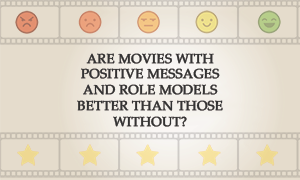 When I’m thinking about what movies I enjoy, I rarely consider whether they have a positive message or contain positive role models. But on a subconscious level, I’m sure these factors play a part in how much satisfaction I get from the flick. For example, I enjoyed The Wolf of Wall Street but felt it was held back by the fact that its characters learnt nothing and were triumphant in their duplicity, selfishness and douchebaggery.
When I’m thinking about what movies I enjoy, I rarely consider whether they have a positive message or contain positive role models. But on a subconscious level, I’m sure these factors play a part in how much satisfaction I get from the flick. For example, I enjoyed The Wolf of Wall Street but felt it was held back by the fact that its characters learnt nothing and were triumphant in their duplicity, selfishness and douchebaggery.
To investigate this topic, I used data from an American nonprofit pressure group called Common Sense Media. They describe themselves as “the largest, most trusted library of independent age-based and educational ratings and reviews for movies, games, apps, TV shows, websites, books, and music“. Their reviewers watch each movie, provide a breakdown of what it contains and award a score out of five for each of the following criteria:
- Positive messages
- Positive role models and representations – As CSM puts it “Are they people you’d like real kids to emulate? Are adults present and responsible? Are the characters realistic and relatable? Are there consequences for their behaviour?“
- Violence / Scariness
- Sexy stuff – incorporating flirting, kissing, nudity and sex
- Bad language – Use of no-no words (such as ***, **** and ****) – we’re not talking solecisms (double negatives, split infinitives and improper empty complementisers).
- Drinking, Drugs and Smoking – a catch-all for
funundesirable substances.
I built a dataset of 5,529 feature films released between 1998 and 2017, gathering both their Common Sense Media scores and audience ratings from IMDb.
How the content of movies changes with their MPAA rating
Let’s start by looking at the levels of each of these six categories across the entire dataset. I’ll first split the films by MPAA rating, as this is the measure American cinema-goers are most familiar with when trying to get a sense of how extreme a movie may be.
As you would expect, levels of violence, sex, drugs, drinking, smoking, and swearing increase as you move up the MPAA rating scale from G to R. And on the flip side, the level of positive messages and role models decline as we move towards R-rated movies.
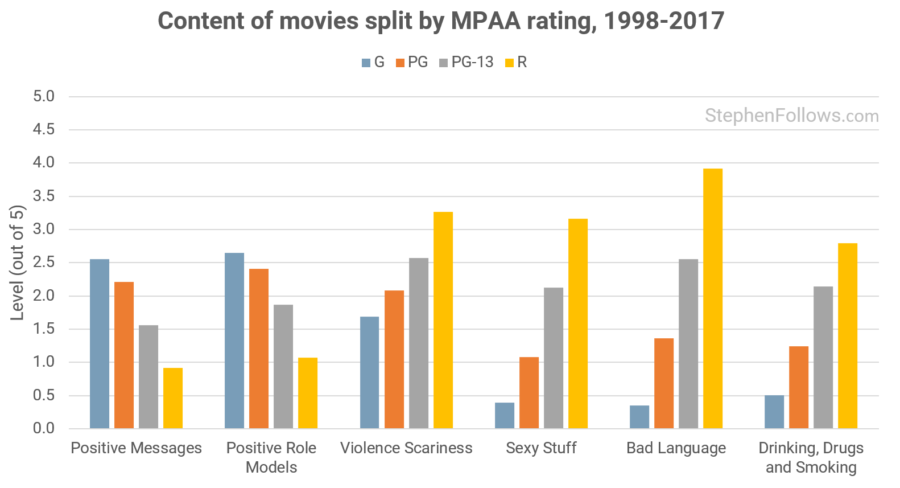
Which genres have the best role models?
Let’s look at how these levels differ by genre.
Among the most wholesome genres are family, animation, biography and adventure. At the other end, with the fewest positive messages and roles models are thrillers, crime and horror movies.
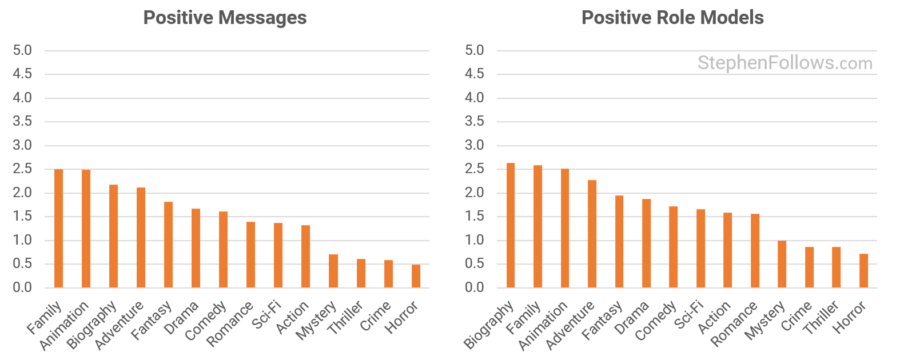
When we look at the negative vices, another story emerges. For example, romantic films are the most likely to have ‘sexy stuff’ and second-but-last to contain violence (making Fifty Shades of Grey quite the outlier). Crime, horror and thriller remain towards the top of both sets of vices, with family at the bottom of both.
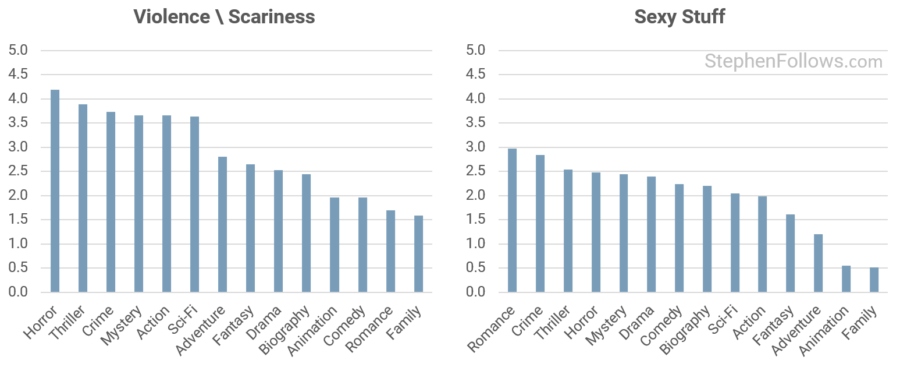
Crime movies have the sweariest characters, who are also the most likely to be drinking, smoking and taking drugs. At the exact opposite end of both spectrums are animated movies.
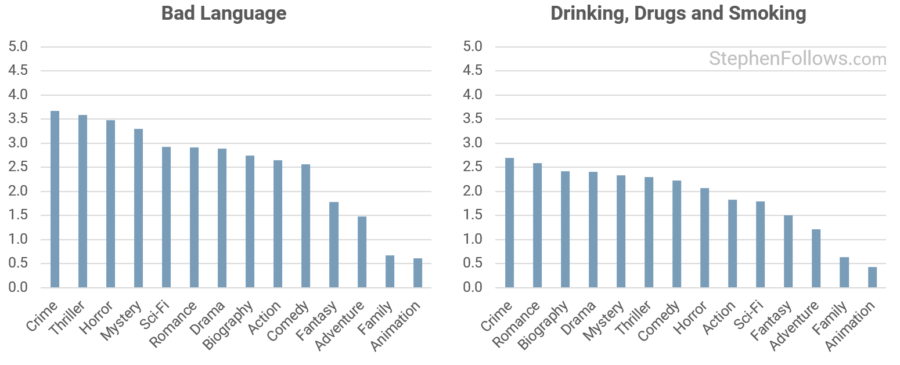
What makes a good film?
Now that we have an idea of what the major genres contain, let’s have a look at what audiences actually want. I’m going to use IMDb’s audience scores as a proxy for quality, thereby allowing us to look for correlations between levels of each vice and to what degree the audience regards it as a good movie.
Using the Pearson correlation coefficient we can generate a score between -1 and 1 for any two sets of numbers. A score of 1 means that they are completely positively correlated (meaning when one goes up, so does the other). A score of -1 tells us that they are completely negatively correlated (so when one goes up, the other goes down), and a score of zero means there is no correlation between the two.
Across the whole dataset, there seems to be the strongest correlation between quality and positive aspects amongst adventure films and comedies. In both cases, films with more of these happy elements tend to be scored higher by film audiences.
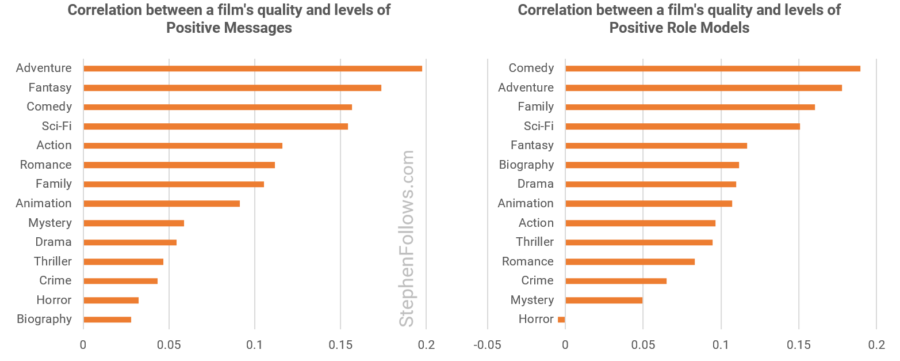
To put this another way, below are the average IMDb scores for comedies and adventure films, split by their levels of positive messages and role models. As you can see, when the positive aspects increase, so too does the average audience score.
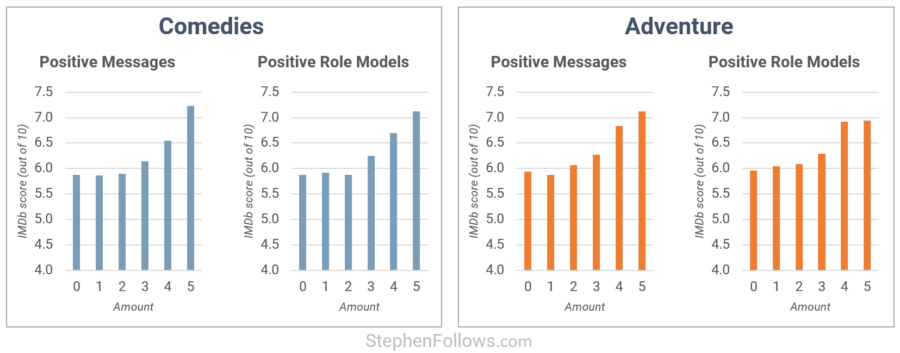
Let’s finish by looking at the correlation between quality and the ‘negative’ vices. Audiences of crime films really want to see violence. To a lesser extent, so too do audiences of romance films. This is fascinating as we have already seen how romance films contain the least violence of all genres, save for family films. This implies that fans of romcoms are being given softer films than they actually want.
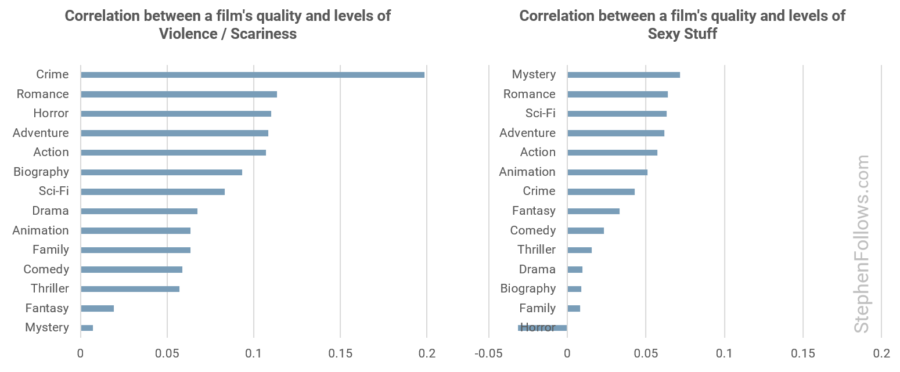
Crime fans always appreciate bad language, drinking, drugs and smoking. Unsurprisingly, higher levels of bad language will decrease the perceived quality of a family film.

Notes
The data for today’s research came from Common Sense Media (for content scores) and IMDb (for audience scores and genre classification).
It’s worth stating the obvious that all such scoring of content is subjective. It’s not possible to truly track an exact, unbiased level of content in a movie without many reviewers watching the same movie and having an objective standard for scoring. That said, Common Sense Media has clear guidelines as well as experienced reviewers who justify their scores and base them on a shared criteria. In the absence of a better measure of a movie’s content, this works well enough for the function needed in today’s research.
There were too few NC-17 films to include them in the MPAA chart.
We’re measuring correlation, not causation. So, for example, just because many crime films with bad language have higher scores, it does not automatically follow that if you add bad language into your crime script that it will suddenly be better. Sorry. It could well be that good writers just swear more than bad ones.
Epilogue
A few years ago, I was involved with a BBC Radio 4 series (and podcast) called The Business of Film. The host Mark Kermode and I discussed what kinds of things I could research for the show and his top suggestion was whether films with happy endings make more money than those with sad endings. Unfortunately it wasn’t possible to follow this thread due to the nebulous concept of a ‘happy’ ending. For example, in Gladiator (spoiler alert!) the hero dies at the end, but only after achieving vengeance against his nemesis and going to heaven. Does that make it a happy ending?
Also, with so many films being released as part of multi-film series, it’s becoming ever-harder to see any film’s ending as the actual end. As anyone who saw Avengers Infinity Wars will attest.
Nonetheless, I’d like to think that some of what I’ve been studying here today speaks to Mark’s wider question about the emotional journey.

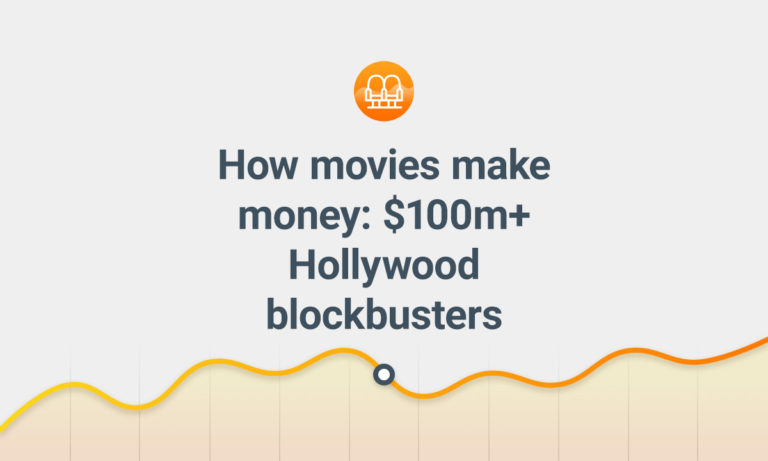
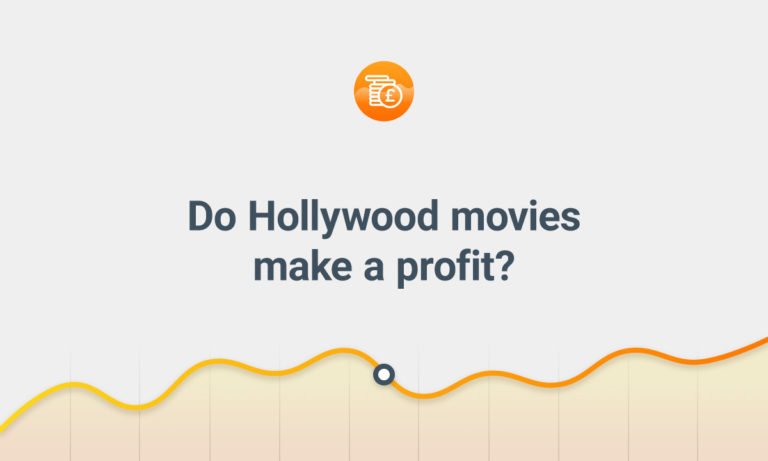
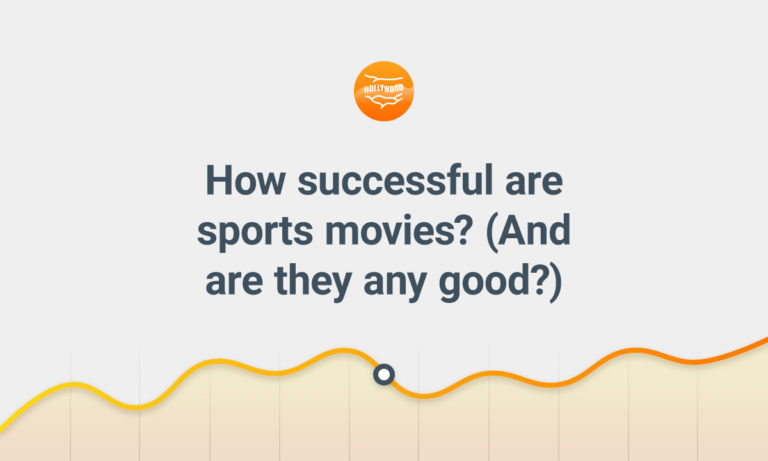

Comments
Dear Mr. Follows (is this really your surname?),
Thank you for going beyond… your data are shown in such a nice way. And everything is written so well, that is enjoyable for me to read and always learn so much!
Thanks, Renata. (Yes, it is. If I were picking a name would I pick this one?)
Do you have a box office correlation with the performance of positive or negative message films?
Great question. I’ve not yet had a chance to look at that. It’s not as simple as box office gross as budget has to be taken into account. But it’s certainly on my to do list
I was about to ask the same question! Just a preliminary look at the top grossing movies gives me the impression that G, PG and PG-13 movies seem to rake in the most cash at the box office. Thanks for your very helpful work, Stephen!
Once again, a thought provoking report and I too would like to see if there is a correlation between box-office and message.
As movie makers are (partially at least) in it for the money, a profitability index may be useful here. A $10m budget movie that books $50m at the box-office is (if we look purely at profits) twice as successful as a $20m budget movie that makes $50m at the B.O.
As a distributor only gets about 40% of the B.O., our $10m movie earned another $10m, whereas the $20m movie earned nothing and would have to look to the ‘Long Tail’ of home consumption for any real earnings.
how do you find all these datas? I love this site. Thank you Stephen
All the data for today’s work is publicly available on IMDb and Common Sense Media websites. The hard bit is gathering and linking the data (oh, and analysing it all).
I understand that we cannot clearly define happy ending (or bad ending), but I tend to believe (with no scientific base at all), that audiences tend to like “satisfactory endings”, in the senses of “endings who makes sense in the context of the movie”. For example, Gladiator makes senses, he achieves his goal (vengeance), but he was living in a world in which a happy ending like, survive, become the new emperor and marrying the girl, won’t make senses at all.
Another example is Rocky: Rocky lose the fight (sad ending) but achieves his goal (self-esteem).
Hello Stephen, First and foremost, congratulations for your blog or newsletter or whatever this site is called. Very good thought-provoking work. For this survey of “Happy” vs. “Sad” ending (cartoon like simplification on my part) I agree with Alejandro who mentions a “Satisfactory” ending. What I’d like to add is the distinction between empathizing with the protagonist with either outcome. Don’t we want to feel uplifted, and therefore justified, in our immagination thereby empathizing more with a protagonist who concludes a satisfactory ending? Does anyone really want to feel that the good guy dies in the end? Aristotle concluded that people wanted to go home (after the theater) feeling uplifted. We all need a “vision” of a positive future for ourselves, so I suspect that satisfactory or positive endings are the most profitable and that the protagonists of these films create the most empathy on the viewer’s part. Can’t wait for your analysis of box office returns!
Great info. Can i share it?
Stephen Follows – absolutely fascinating! I’ll keep your excellent message in mind as I make my new film.
Sincerely,
Joe Masefield